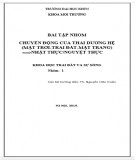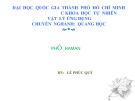
MINISTRY OF EDUCATION
AND TRAINING
VIETNAM ACADEMY OF SCIENCE
AND TECHNOLOGY
GRADUATE UNIVERSITY OF SCIENCE AND TECHNOLOGY
-----------------------------
PHAM NGOC CHUNG
INVESTIGATION OF TEMPERATURE RESPONSES
OF SMALL SATELLITES IN LOW EARTH ORBIT
SUBJECTED TO THERMAL LOADINGS
FROM SPACE ENVIRONMENT
Major: Engineering Mechanics
Code: 9 52 01 01
SUMMARY OF THE DOCTORAL THESIS
Hanoi – 2019

The thesis has been completed at Graduate University of Science and
Technology, Vietnam Academy of Science and Technology
Supervisor 1: Prof.Dr.Sc. Nguyen Dong Anh
Supervisor 2: Assoc.Prof.Dr. Dinh Van Manh
Reviewer 1: Prof.Dr. Tran Ich Thinh
Reviewer 2: Prof.Dr. Nguyen Thai Chung
Reviewer 3: Assoc.Prof.Dr. Dao Nhu Mai
The thesis is defended to the thesis committee for the Doctoral Degree,
at Graduate University of Science and Technology - Vietnam Academy
of Science and Technology, on Date.....Month.....Year 2019
Hardcopy of the thesis can be found at:
- Library of Graduate University of Science and Technology
- National Library of Vietnam

1
INTRODUCTION
1. The rationale for the thesis
In the past decades, the problem of nonlinear behavior analysis
of dynamical systems is of interest of researchers from over the
world. In the field of space technology, satellite thermal analysis is
one of the most complex but important tasks because it involves the
operation of satellite equipment in orbit. To explore the thermal
behavior of a satellite, one can use numerical computation tools
packed in a specialized software. The numerical computation-based
approach, however, needs a lot of resources of computer. When
changing system parameters, the calculation process of thermal
responses may require a new iteration corresponding to the
parameter data under consideration. This leads to an “expensive”
cost of computation time. Another approach based on analytical
methods can take advantage of the convenience and computation
time, because it can quickly estimate thermal responses of a certain
satellite component with a desired accuracy. Until now, there are
very little effective analytical tools to solve the problem of satellite
thermal analysis because of the presence of quartic nonlinear terms
related to heat radiation. For the above reasons, I have chosen a
subject for my thesis, entitled “Investigation of temperature
responses of small satellites in Low Earth Orbit subjected to thermal
loadings from space environment” by proposing an efficient
analytical tool, namely, a dual criterion equivalent linearization
method which is developed recently for nonlinear dynamical
systems.

2
2. The objective of the thesis
- Establishing thermal models of single-node, two-node and
many-node associated with different thermal loading models acting
on a small satellite in Low Earth Orbit.
- Finding analytical solutions of equations of thermal balance
for small satellites by the dual criterion equivalent linearization
method.
- Exploring quantitative and qualitative behaviors of satellite
temperature in the considered thermal models.
3. The scope of the thesis
The thesis is focused to investigate characteristics of thermal
responses of small satellites in Low Earth Orbit; the investigation
scope includes single-node, two-node, six-node and eight-node
models.
3. The research methods in the thesis
The thesis uses analytical methods associated with numerical
methods:
- The method of equivalent linearization; Grande’s
approximation methods;
- The 4th order Runge-Kutta method for solving differential
equations of thermal balance.
- The Newton-Raphson method for solving nonlinear algebraic
systems obtained from linearization processes of thermal balance
equations.
4. The outline of the thesis
The thesis is divided into the following parts: Introduction;
Chapters 1, 2, 3 and 4; Conclusion; List of research works of author
related to thesis contents; and References.

3
CHAPTER 1. AN OVERVIEW OF SATELLITE THERMAL
ANALYSIS PROBLEMS
- Chapter 1 presents an overview of the thermal analysis
problem for small satellites in Low Earth Orbit.
- In Low Earth Orbit, a satellite is experienced three main
thermal loadings from space environment, namely, solar irradiation,
Earth's albedo and infrared radiation. In the thesis, these loadings are
formulated in the form of analytical expressions, and they can be
easily processed in both analytical and numerical analysis.
- The author presents the thermal modeling process for small
satellites based upon the lumped parameter method to obtain
nonlinear differential equations of thermal balance of nodes. The
author has introduced physical expressions of thermal nodes in
detail, for example heat capacity, conductive coupling coefficient,
radiative coupling coefficient. For satellites in Low Earth Orbit, the
main mechanisms of heat transfer are thermal radiation and
conduction through material medium of spacecraft (here, convection
is considered negligible).
CHAPTER 2. ANAYSIS OF THERMAL RESPONSE
OF SMALL SATELLITES USING SINGLE-NODE MODEL
2.1. Problem
Thermal analysis is one of the important tasks in the process of
thermal design for satellites because it involves the temperature limit
and stable operation of satellite equipment. For small satellites, the
satellite can be divided into several nodes in the thermal model. In
this chapter, a single-node model is considered. The meaning of
single-node model is as follows: (i) this is a simple model that allows
estimating temperature values of a satellite, a certain component or

![Các mô hình vũ trụ: Khóa luận tốt nghiệp đại học [chuẩn nhất]](https://cdn.tailieu.vn/images/document/thumbnail/2021/20211102/cucngoainhan2/135x160/4801635817241.jpg)







![Buồng cộng hưởng quang học và sự truyền tia laser: Bài thuyết trình [Mới nhất]](https://cdn.tailieu.vn/images/document/thumbnail/2016/20160916/maiyeumaiyeu09/135x160/951474015603.jpg)




![Ô nhiễm môi trường không khí: Bài tiểu luận [Nổi bật/Chi tiết/Phân tích]](https://cdn.tailieu.vn/images/document/thumbnail/2025/20251011/kimphuong1001/135x160/76241760173495.jpg)







![Ứng dụng kỹ thuật trao đổi ion trong điện phân: Bài tiểu luận [chuẩn nhất]](https://cdn.tailieu.vn/images/document/thumbnail/2025/20250829/sonphamxuan1808/135x160/97341756442892.jpg)



